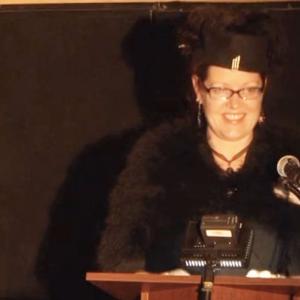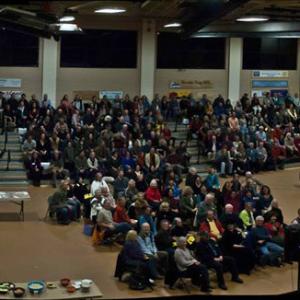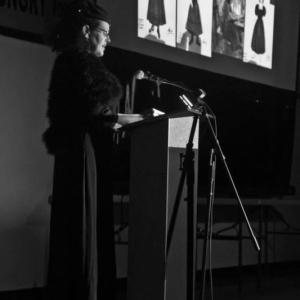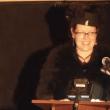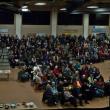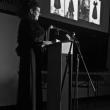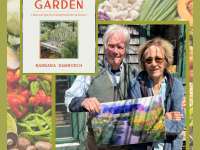Behind The Slides: What it’s like to be a professional theatrical costume designer
 Kathleen P. Brown, a professional theatrical costume designer, was one of the Pecha Kucha Rockland artists featured Nov. 15. (Screenshot courtesy Pecha Kucha)
Kathleen P. Brown, a professional theatrical costume designer, was one of the Pecha Kucha Rockland artists featured Nov. 15. (Screenshot courtesy Pecha Kucha)
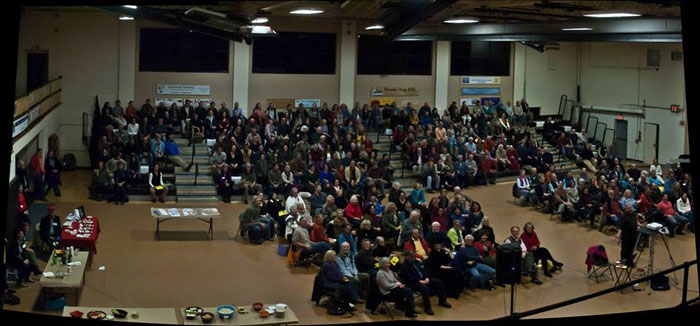 The crowd at the Rockland Rec Center for Pecha Kucha Night. (Courtesy Jesse Robert Gifford Stuart)
The crowd at the Rockland Rec Center for Pecha Kucha Night. (Courtesy Jesse Robert Gifford Stuart)
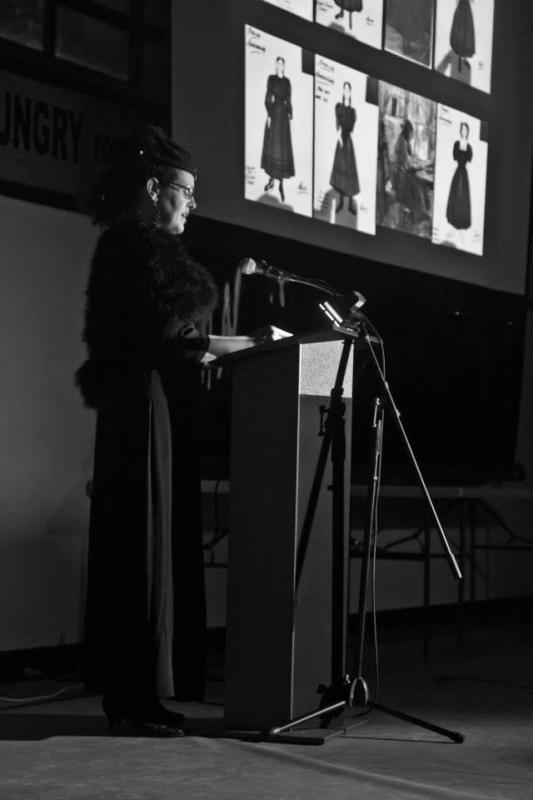 Kathleen Brown takes the stage for her presentation. (Courtesy Jesse Robert Gifford Stuart)
Kathleen Brown takes the stage for her presentation. (Courtesy Jesse Robert Gifford Stuart)
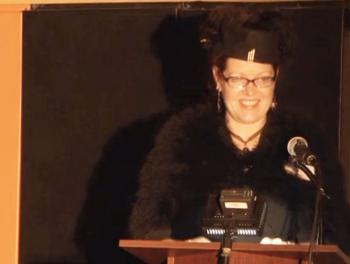 Kathleen P. Brown, a professional theatrical costume designer, was one of the Pecha Kucha Rockland artists featured Nov. 15. (Screenshot courtesy Pecha Kucha)
Kathleen P. Brown, a professional theatrical costume designer, was one of the Pecha Kucha Rockland artists featured Nov. 15. (Screenshot courtesy Pecha Kucha)
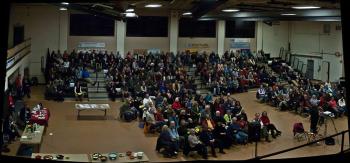 The crowd at the Rockland Rec Center for Pecha Kucha Night. (Courtesy Jesse Robert Gifford Stuart)
The crowd at the Rockland Rec Center for Pecha Kucha Night. (Courtesy Jesse Robert Gifford Stuart)
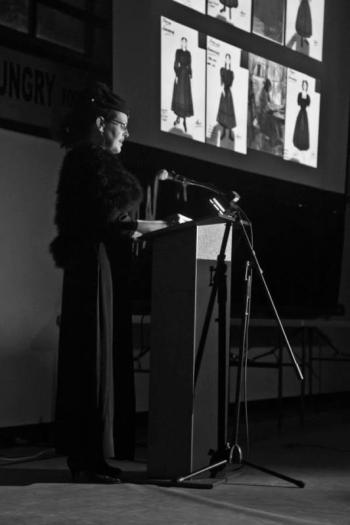 Kathleen Brown takes the stage for her presentation. (Courtesy Jesse Robert Gifford Stuart)
Kathleen Brown takes the stage for her presentation. (Courtesy Jesse Robert Gifford Stuart)
Welcome to our ongoing feature Behind The Slides, where we meet up with an artist who just presented at Pecha Kucha Night and find out the deeper story beneath the images they chose to portray.
Kathleen P. Brown was one of the presenters at Pecha Kucha, held at the Rockland Recreation Center earlier this month. Like the other presenters, she took the audience through her creative process in a visual storytelling format with a 20-second-per-image, 20-image slideshow. Brown has been a professional theatrical costume designer for 30 years and got her Bachelor of Fine Art in theatrical production design from Ithaca College in 1987. Her costume designs have frequently appeared all over the state: at Portland Stage, The Public Theatre, Monmouth Theatre Company, Bates College Theater, Colby College Theater, Northport Music Theater and at the Lyric Stage Company and the New Jersey Shakespeare Company. Kathleen has also designed costumes for the School of Performing Arts at the University of Maine at Orono for the past four years, where she has also acted as adjunct faculty.
Note: Rather than over-explain it, we will provide a sample of Brown's Pecha Kucha slides in the right column. Click on the photos to match them with the actual slide notes (in italics). Beneath the slide notes will be the deeper story.
Grandma Shae
It all started with my Grandma Shea, who taught me how to hand sew at the age of 8. She was an amazing woman who traveled alone from Ireland to America at 16. She worked in a sweatshop in New York City until she met my Grandpa. Grandma would tell me stories of copying dress designs from B. Altman & Saks 5th Avenue.
At a young age I started sewing costumes for my dolls, for my family as well as for myself. I became an avid "people watcher," and often sketched a variety of characters from real life situations. In high school I discovered theater and began working backstage doing costumes and makeup. In the summers, I worked for the Camden Shakespeare Company, which back in the 80s had a wonderful repertory season that performed six nights a week in the Camden Amphitheater. Theater seemed to be the perfect match with my artistic and creative skills. With the wonderful support of my grandma as well as my mom, dad and brother, I went on to study theatrical costume design in college.
The process
Costume Design is a process: reading the script; analyzing the characters, research, creating sketches and renderings that work within the play and for the characters. All of this involves many meetings with the director, and discussions with the actors. These are my research and renderings from Spring Awakening at UMO.
Most people do not realize how much pre-production work goes into creating costume designs. The process takes weeks or months, and every detail is meticulously thought out and discussed. Research is one of my favorite parts; most costumers are actually costume history "nerds," who love searching for the perfect piece of research that will provide inspiration for a character's costume. Most of these renderings are duplicates of an actual Victorian dress with a few personalizations.
The steps
Creating an idea on paper is just the beginning, then there are a series of steps: measurements of the actors, creating patterns of the costumes, shopping for fabric, trims and accessories, cutting out and sewing of the costumes. Many fittings are involved before the finished costumes go on stage.
To transition from the two-dimensional to the three-dimensional is the most time consuming and intense part of the design process, taking an average of six weeks to "build" a show from paper to finished costumes. Strong verbal and visual communication with the director, actors and especially the costume shop is key to a successful design. Finding the right fabric and trims these days is a challenge. I work the most with the actors in fittings, making sure that the costume fits well, is comfortable and is appropriate for their character. Although I have a lot of respect for actors, I often encounter problems such as body issues, insecurities, big egos and feet that are extra wide or have painful bunions. This requires patience, and creating an environment of trust.
Spring Awakening
These are the principal girls’ costumes from the play, Spring Awakening. They also needed to be able to dance energetically, and yet it was important that they look like Victorian schoolgirls. I chose more modern colors in order to emulate their "budding innocence"...like spring flowers.
Spring Awakening is a story about teenagers becoming aware of their sexuality within the repressed world of a Victorian boarding school. Because the set and other characters were all in a traditional somber Victorian palette, I really loved putting vibrant "punches" of color on the girls, representing their blooming sexuality and lively innocence. The schoolgirls also needed a lot of freedom of movement in order to dance, so we built the dresses without too much structure (as they would have been during the late 1900s).
Pirates of Penzance
Once in a while, costume designers get a rare opportunity to create some completely FUN costumes! This was true for my designs for Pirates of Penzance at UMO. I created each pirate costume as a caricature of a well-known pirate.
The director and I came up with the concept to costume each pirate based on an infamous pirate character, such Capt. Hook, Blackbeard and Capt. Jack Sparrow. This involved building, purchasing and renting numerous pieces and accessories in order to make each pirate character recognizable. I also had to put wigs and facial hair on most of the actors.
Hair
Hair was an amazing challenge in that it involved a great deal of historical and political research, in order to truly understand the content of the musical. I purchased most of the costumes as vintage pieces from the late 60s and early 70s. The wigs were a bit of a challenge, as most of the actors had short hair.
The director insisted on extensive research about the Vietnam War and the anti-war movement. I decided to use actual vintage clothing from this time period in order for each actor/character to look as if he or she were in their own clothing, versus a "costume." There were many costume pieces in this production, as there are quite a few scenes where the actors are in an entirely different locale. Since the set was very basic, with only lighting used to express the change of scenery/mood, the costume changes became extremely important. This created a lot of quick changes, almost everyone had to wear wigs, and then there is the nude scene. The biggest issue in the nude scene was where to place the body mics...they wound up in the wigs, which created additional bulk and a certain amount of discomfort for the actors.
Nude scenes
Underwear can also be a challenge when faced with near-nudity onstage. In these two productions, I was required to make my actors feel very comfortable with an intimate situation.
In Hair, the lead actor has to rip off his breakaway jeans onstage, and sings and dances to a number wearing nothing but a fringed leather G-string. In order to protect the actor's private parts from being revealed, I had to purchase and fit a nude thong on the actor.
For Enchanted April, the actor abruptly emerges onstage from having been ready to take a bath, but the hot water heater has just exploded. Wearing nothing but a towel and a boater, the script calls for the actor to accidentally drop his towel, to quickly cover his private parts with his hat. The director insisted that I find the actor a nude thong so that the actors and audience would not have to be witness to unmentionable body parts. Both situations required all involved to have a good sense of humor and to be not even remotely bashful.
If you missed this Pecha Kucha Night, not to worry. Belfast Community Television (BCTV-2) will be airing the presentation Friday, Nov. 29, at 10 p.m. and Saturday, Nov. 30, at 8:30 p.m. This presentation can also be seen on line at belfastcommunitytv.org. Follow Kathleen P. Brown and her work on Facebook. For more information about Pecha Kucha visit them on Facebook.
Kay Stephens can be reached at news@penbaypilot.com
Event Date
Address
United States

